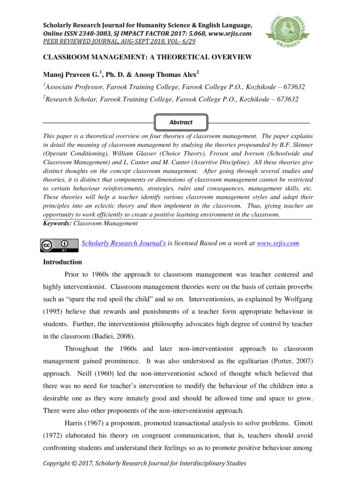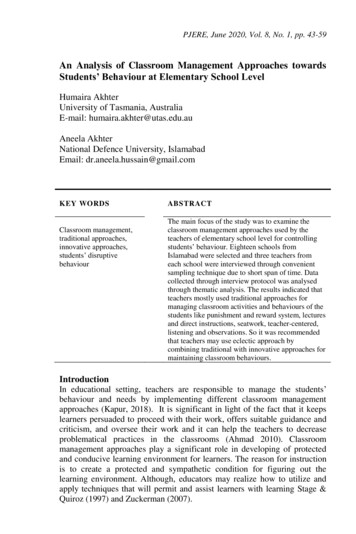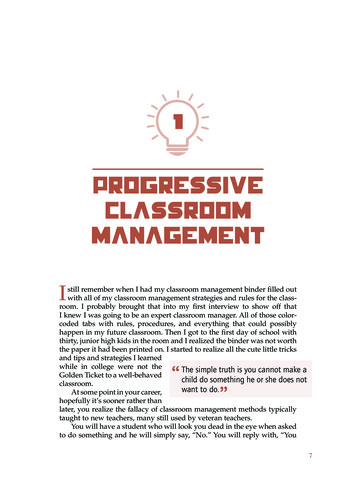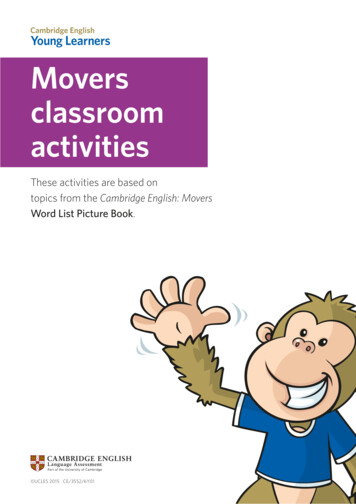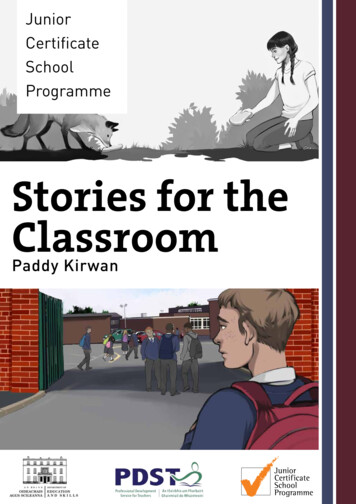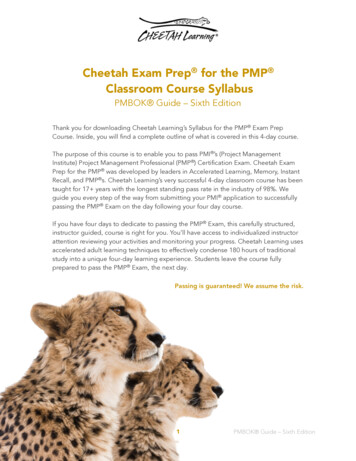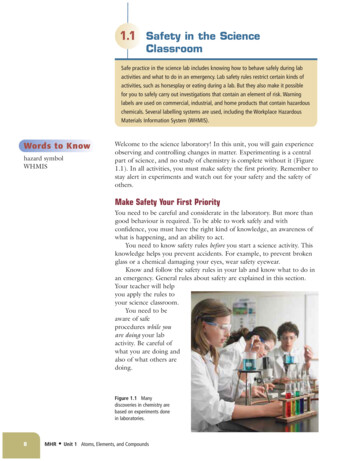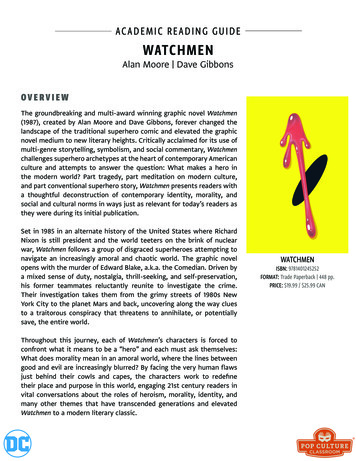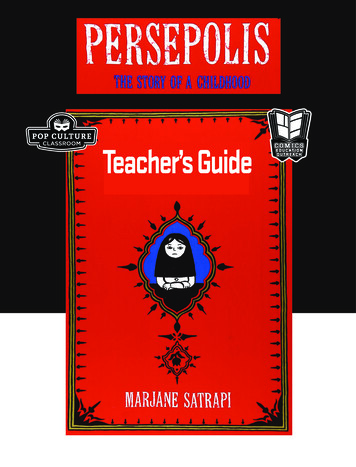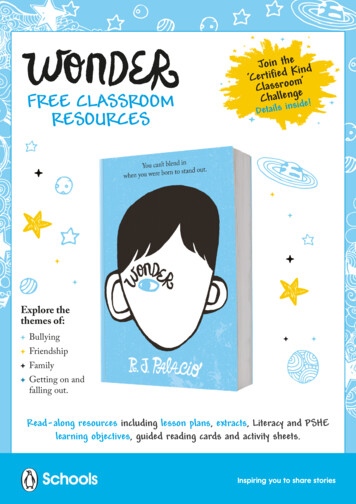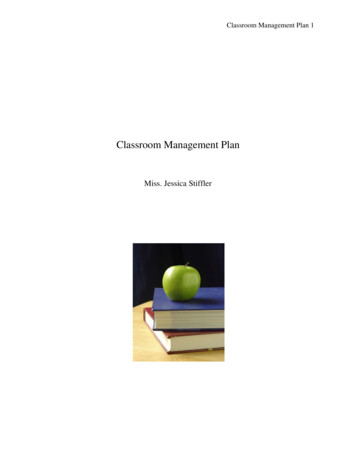
Transcription
Classroom Management Plan 1Classroom Management PlanMiss. Jessica Stiffler
Classroom Management Plan 2Classroom Management PlanJessica StifflerEducation 360November 22, 2010
Classroom Management Plan 3Descriptive StatementThe following document consist of my personal beliefs and practices for managing aclassroom of diverse students. Throughout observations, classroom lessons, and personalexperiences, I have observed many different theories on education and classroom management.As part of previous course work, I have learned about the different theories and theorist that havehelped form my teaching style and beliefs. The following document includes my philosophy ofclassroom management, procedures and routines, and how I will implement these in myclassroom.Philosophy of Classroom ManagementOver the years, many theorists have studied best practices in education includingclassroom management. After researching and studying the ideas and beliefs of many theorists, Ihave determined several ideas and theories that match my unique style of teaching. Some of thetheorist that I found intriguing, and who are included in my top ten beliefs and practices areWilliam Glasser’s ideas on The Choice Theory; Harry and Rosemary Wong’s theories aboutclassroom procedures and discipline; and Marvin Marshall and the Discipline through RaisingStudent Responsibility Theory. By applying the ideas of these theorist and those of several othertheorists, I will provide a positive and safe classroom environment for my students to responsiblywork together to form a community of learners.
Classroom Management Plan 4Top Ten Beliefs/Practices1. William Glasser, theorists and creator the The Choice Theory, holds many of the samebeliefs that I have on education and classroom management. Glasser’s Choice Theory isthe main theory on which my philosophy of education and behavior management is built.The Choice Theory is based on the idea that students are responsible for their behaviors,and that each individual can control how he or she behaves. I too believe in eachindividual’s ability to control behavior. Everyone has the option to misbehave or tobehave in positive ways. When working with students, I will stress the importance ofthinking about their behavior before they misbehave. In order to help the students managetheir behaviors, I will model behaviors using think alouds on how I should control myactions. I will also stress the importance of good decision-making and conflict resolutionby having students use their writer’s notebooks to submit daily reflections on theirbehavior and possible alternatives if the behavior was unnecessary or unwanted.2. Glasser believed in “lead teaching” verses “boss teaching.” “Lead teaching” is teachinga group of students in positive ways in which there are strong student-teacherrelationships. “Boss teaching” occurs when a teacher wants to be a controller and notallow students to give their ideas and desires. I agree with Glasser that it is important tobe a “lead teacher.” By being positive and open with students, the classroom will be a funand safe place for students to learn and grow as a community of learners. I will worktogether with my students and avoid the seven deadly habits that lead to “boss teaching.”Teaching is not controlling, but rather working with the students to learn, grow, andsucceed together. By having strong student-teacher relationships with students, the
Classroom Management Plan 5classroom will be a safe place for each member of the community of learners to expresstheir feelings and work together. Academic success depends on these close relationshipsand guidance that teachers and students have with one another.3. Theorist Jacob Kounin stressed the importance of “with-it-ness,” which is the idea thatthe teacher knows what is going on in their classroom at all times. They understand theimportance of having a close eye on students. Teachers who have “with-it-ness” are ableto spot areas where misbehavior may arise, when students are upset, and are able correctproblem behaviors before they cause major distress to the classroom. These teachers areable to manage their classrooms at all times and prevent problems from occurring orexpanding. In a community of learners, it is the duty of the teacher to make sureeverything runs smoothly for students. By being able to spot problem behaviors beforethey get out of line, I will be keeping my community of learners on tasks and helpingkeep a safe learning environment. Many problem behaviors occur during transitions. Byhaving set procedures and routines, I will be able to eliminate behavior problems beforethey arise. I hope that through experiences, I will develop the strong “with-it-ness” skillsto manage my classroom.4. Jacob Kounin also believed that if students were engaged in their lessons, they would beless likely to misbehave. Other theorists who believed this as well were Glasser, Curwin,and Medler. If lessons are precise and completed at a steady continuous pace, studentswill have little down time to misbehave or to get into conflicts. When students areengaged, they are concentrating on the lesson and activities. This helps students focus
Classroom Management Plan 6their behaviors on curiosity and learning, and it prevents problem behaviors fromoccurring. I will create lessons that are engaging to students and fun. Students will havea say in what is interesting and important to them, and these will be stressed upon in theclassroom. It is important for the students to be part of the decision-making processes sothat they know they are valuable members of the community of learners. If students arehaving fun, they will be engaged. When they are engaged in a lesson, they will not thinkabout misbehaving, and will be focused on the task. By making lessons engaging and funfor students, I will have fewer behavior problems come up during lessons and thestudents will have fun instead of having conflicts with one another.5. Many problem behaviors occur during transitions. Whether it is a transition from room toroom or simple transitions between lessons, students are likely to misbehave during thesedown times. To help eliminate conflicts and behavior problems from occurring,procedures and routines need to be implemented the first day of school. This idea ofprocedures and routines come from Harry Wong. When procedures and routines are putinto play, students know what is expected and how to act. This keeps behavior problemsto a minimum and allows for structure. I will model procedures and routines the first dayof school so that students know what is expected. There will be a routine or procedure foreach transitional part of the day. By being responsible and working together, thecommunity of learners will follow through with the procedures and routines in safe andpositive ways. Through practice, students will master the procedures and routines.
Classroom Management Plan 76. According to Spencer Kagan, students should play an active role in setting classroomrules. Kagan also believed that there should be no more than five rules and they should beshort worded for clear understanding. I agree with Kagan, and I have set this idea as oneof my top ten beliefs. I am a strong advocate for student responsibility and involvement.By allowing the students to help create the rules and expectations, the students areparticipating in classroom community building. Everyone is working together and is ableto clearly understand the rules and expectations. The rules and expectations will beposted on the wall so that students are always aware of what is expected.7. I believe that communicating with parents about classroom behaviors and management isextremely important. Canter believed that parents need to be informed prior to day oneabout behavior and consequences. Both positive and negative consequences should beshared with parents and guardians. By writing a letter at the beginning of the year, I willhelp create a positive teacher-parent relationship. Parents should know how their childrenare behaving in class, whether it is good or bad. By keeping in touch with letters andnotes, emails, or phone calls, parents will feel as if they are important to their child’ssuccess in the classroom. If parents do not feel important to their children’s education, orwelcome in the classroom, the students will suffer. There must be a good teacher-parentrelationship so that everyone is on the same page to support the student’s needs. If thereis no support at home, the student will struggle in the classroom.8. Jacob Kounin created the idea of the “ripple effect.” The idea is that if one studentsustains positive or negative consequences, the rest of the class will see what is taking
Classroom Management Plan 8place and a ripple effect will occur. From experience, when one student misbehavesothers will join in as well. On the other hand, a student receiving a reward for sittingquietly at her seat will cause other students to then join her in sitting quietly. I chose thisas one of my top beliefs because managing students’ behavior in positive ways is the keyto success. In a community of learners, everyone works together. By being aware of theripple effect, I will provide positive and negative consequences for my students’ actions.I believe that the “ripple effect” does occur and that each moment can be used as ateaching moment for students, even if it means giving a reward. Students learn fromothers around them, and by believing in the ripple effect, I will be able to managebehaviors by addressing behaviors one or two times for students to learn what isexpected.9. The Canters believed that teachers should teach and model classroom behaviors. Bydoing so, students are able to visually see what is expected and what is not allowed in theclassroom. This is important so that students fully understand what it looks like toparticipate in positive behavior management. I will model these behaviors to students andhave them practice them so they know what each feels like and looks like in ourclassroom. The classroom is to be a community of learners where everyone is safe andresponsible. Students will learn to be responsible managers of their behavior by seeingothers do what is expected. If students see the behaviors being modeled, they will knowwhat is expected, and will then be able to participate in the wanted behaviors throughoutthe school year. It may take time to get all students on the same page, but it will be wellworth the wait when the students finally grasp what is expected.
Classroom Management Plan 910. Glasser believed that when students misbehave, it is important to sit down with thestudent and ask what you, the teacher can do to help. Then, there should be classdiscussions and meetings on what behaviors took place and how things could have beenhandled differently in a positive way. I agree that teachers need to be open with studentsand take into consideration the possible reasons that may lie behind the behaviors of thestudents. If you punish and do not take the time to figure out the underlying reasons, youmay not change the behavior. I will take the time to talk with my students and give themthe opportunity to share their frustrations and conflicting behaviors. By having closestudent-teacher relationships, I will be able to get to the cause of the behavior and helpthe student come up with alternatives to prevent the unwanted behavior from occurring inthe future.
Classroom Management Plan 10Procedures and RoutinesBeginning of the DayFor the beginning of the day routine, students will enter the classroom and remove allschoolwork and needed items from their backpacks onto their desks. Students will then hang uptheir coats and bags in the designated area and return to their seats. Students will be allowed totalk quietly during this time. The students will then turn in homework assignments, and anynotes in the “turn in tray” and any lunch money in the “lunch money tray” both located on thecorner of the teacher’s desk. Students should also take this time to organize their desk and placea sticker by their name for attendance on the attendance chart. Once they have put away theirbelongings, handed in necessary items, and placed a sticker on the attendance chart, the studentswill return to their seats and quietly write in their writer’s notebooks. There will be a topic listedon the board for the students to address in their writings. Once the Pledge of Allegiance andannouncements come on, students will stop writing and listen quietly. Following announcements,students will be given five minutes to finish their writings and return their writer’s notebooksinside their desk. From there, the students will join a five-minute sharing circle where thestudents will review the lessons from the previous day and the class mission to be good learners!The beginning of the day sets the mood for students. The beginning of the day needs to beorganized and set up to make the rest of the day a success. The students will learn the proceduresand routines, which will prevent confusion and bad behaviors during the morning activities. Theteacher will model the routines and procedures so that the students are able to visually see whatis expected. To make it a success, the teacher needs to make sure the “turn in tray” and “lunchmoney tray” are both in their correct location at the corner of the teacher’s desk. The teacher alsoneeds to have the writing prompt posted in on the board in the correct location.
Classroom Management Plan 11Getting Attention/Signaling for QuietDuring group work, partner activities, and other daily tasks, the noise level can oftentimes get too high. When the teacher wants to lower the noise volume, or simply get the attentionof the class, there needs to be signal so that all the students know they are expected to be quietand listen for directions. If all students know the signal, ther
Jacob Kounin also believed that if students were engaged in their lessons, they would be less likely to misbehave. Other theorists who believed this as well were Glasser, Curwin, and Medler. If lessons are precise and completed at a steady continuous pace, students will have little down time to misbehave or to get into conflicts. When students are
